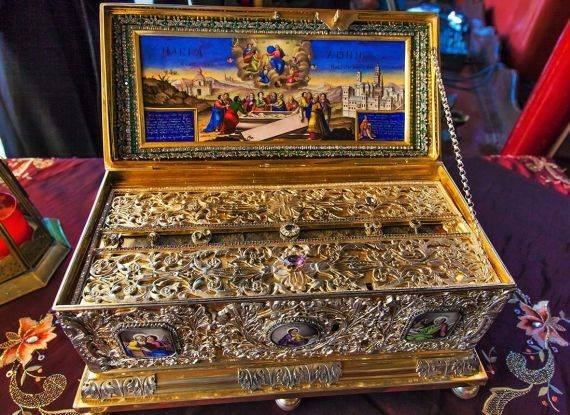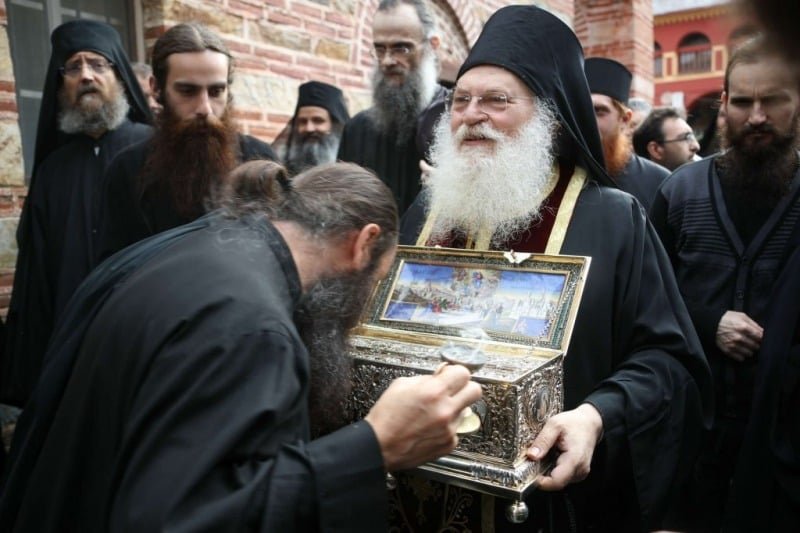THE HOLY BELT (ZONI) OF THE MOST HOLY THEOTOKOS

The History of the Holy Belt
According to the sacred tradition and history of our Church, three days after her Dormition, the Most Holy Theotokos was resurrected and ascended bodily into the heavens. Thomas the Apostle was the only one among the Apostles to witness the miraculous Assumption of the Theotokos. He asked the Virgin Mary to bless him with her Belt. As she ascended into the heavens, she threw the sacred relic to him. Thus, the Precious Belt serves as evidence for our Church of the resurrection and ascension of the Theotokos, in one word, her Assumption.
The safeguarding of the Holy Belt was undertaken by two poor and devout women in Jerusalem, who cared for the Theotokos. They received the sacred relic with reverence, and from then on, the task of its preservation was passed down through generations by a devout virgin from this family. Empress Zoe, wife of Leo VI the Wise, out of gratitude, embroidered the Belt with golden thread, as it is preserved today.
The translation of the Precious Belt and its transfer to Constantinople was carried out by Emperor Arcadius (395-408). The reception of the holy relic in the capital was majestic. Subsequently, the Holy Belt was segmented, and pieces of it were distributed to various churches in Constantinople. After the city’s conquest by the Crusaders in 1204, some pieces were taken by the barbaric and uncivilized conquerors and transported to the West. Following the fall of Constantinople to the Turks in 1453, the fate of the remaining parts of the Holy Belt is unknown. Thus, the only surviving part is the one kept at the Holy Monastery of Vatopedi, having arrived there through extraordinary circumstances. Emperor John VI Kantakouzenos (1347-1355), who had a special affection for the Holy Great Monastery of Vatopedi, as evidenced by numerous testimonies, donated it to the monastery. The Holy Belt is kept in a silver case of more recent construction, which bears the depiction of the Monastery. In the lower right compartment of the depiction, the craftsman fashioned the figure of the donor, Emperor Kantakouzenos, along with an inscription referring to his donation to the Monastery.
Another piece of the Holy Belt was donated by Lazar, ruler of Serbia and later a Great Martyr. According to tradition, Emperor Constantine the Great had made a cross which he took on his campaigns to protect himself and his army. In the middle of the cross was a piece of the True Cross, while it also had compartments with holy relics and a piece of the Holy Belt. During a campaign against the Bulgarians, Emperor Isaac II Angelos was defeated by Prince Asen, and the Bulgarians seized the royal cross. After a victorious campaign, the cross passed to the Serbs, where Lazar donated the Cross and the piece of the Holy Belt.
A multitude of faithful have flocked and continue to flock to venerate it with reverence, asking the Virgin Mary to intercede with her prayers to the Lord. The Holy Belt has performed and continues to perform numerous miracles. People in distress and pain find solace in the miraculous power of the holy relic. For this reason, it was praised by renowned people of the time. Through the grace of the Virgin Mary, it sanctifies the faithful who approach it devoutly, elevates them from corruption, and frees them from illnesses and sorrows. It especially helps women to conceive. If they reverently seek the Virgin Mary’s help, they are given a piece of ribbon that has been blessed in the reliquary of the Holy Belt.
The official celebration was established on August 31st during the reign of Manuel I Komnenos (1143-1180).
Article taken from The Holy and Great Monastery of Vatopedi website.
LINK TO WHERE YOU CAN ACQUIRE A RIBBON BLESSED ON THE HOLY BELT BELOW. A DOCUMENTARY SHOWING THE HOLY BELT ALSO BELOW

Abbott Ephraim of Vatopedi holding the holy belt in a procession
